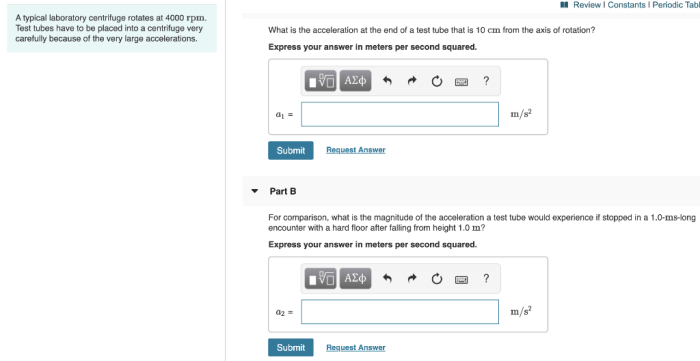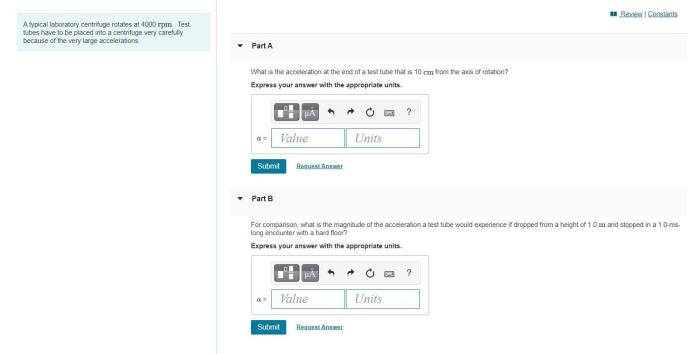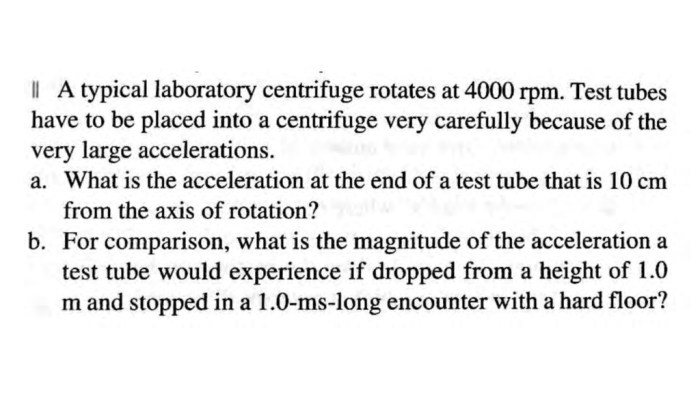A typical laboratory centrifuge rotates at 4000 RPM, providing the foundation for various applications in research and industry. This introductory paragraph delves into the realm of centrifugation, exploring the concept of revolutions per minute (RPM) and its significance in laboratory settings.
The subsequent paragraphs will delve into the intricacies of centrifugal force, examining its relationship with centrifuge speed. Furthermore, the diverse applications of centrifugation will be elucidated, highlighting how different RPM ranges cater to specific experimental needs.
Centrifuge Speed

A laboratory centrifuge is a device that uses centrifugal force to separate particles in a liquid suspension. The speed of a centrifuge is measured in revolutions per minute (RPM). The higher the RPM, the greater the centrifugal force and the more effectively the particles will be separated.
Typical RPM ranges used in laboratory centrifuges vary depending on the application. For example, a low-speed centrifuge may operate at 1,000-3,000 RPM, while a high-speed centrifuge may operate at 10,000-20,000 RPM or even higher.
The selection of centrifuge speed is influenced by several factors, including the size and density of the particles, the viscosity of the liquid, and the desired degree of separation.
Centrifugal Force

Centrifugal force is the outward force that acts on an object moving in a circular path. In a centrifuge, centrifugal force is generated by the rotation of the rotor. The faster the rotor rotates, the greater the centrifugal force.
The relationship between centrifuge speed and centrifugal force is given by the following equation:
F = m
- r
- ω2
where:
- F is the centrifugal force in newtons
- m is the mass of the object in kilograms
- r is the radius of the rotor in meters
- ω is the angular velocity of the rotor in radians per second
Applications of Centrifugation
Centrifugation has a wide range of applications in a laboratory setting, including:
- Separating cells from a liquid suspension
- Separating proteins from a cell lysate
- Preparing samples for electron microscopy
- Measuring the density of a liquid
Different RPMs are used for different applications. For example, a low-speed centrifuge may be used to separate cells from a liquid suspension, while a high-speed centrifuge may be used to separate proteins from a cell lysate.
Centrifuge Design and Operation

A laboratory centrifuge consists of a rotor, a motor, and a control panel. The rotor is the part of the centrifuge that spins and holds the samples. The motor drives the rotor, and the control panel allows the user to set the speed and time of the centrifugation.
To operate a laboratory centrifuge safely, it is important to follow the manufacturer’s instructions. The following steps provide a general overview of how to operate a laboratory centrifuge:
- Place the samples in the rotor and secure the lid.
- Set the speed and time of the centrifugation using the control panel.
- Start the centrifuge.
- Once the centrifugation is complete, stop the centrifuge and open the lid.
- Remove the samples from the rotor.
Safety Considerations
There are several potential hazards associated with using a centrifuge, including:
- Rotating parts
- High-speed rotors
- Biohazardous materials
To minimize the risk of injury, it is important to take the following safety precautions when operating a centrifuge:
- Always wear gloves and eye protection when operating a centrifuge.
- Never operate a centrifuge that is not properly balanced.
- Never open the lid of a centrifuge while it is running.
- Follow the manufacturer’s instructions for cleaning and maintaining the centrifuge.
FAQ Guide: A Typical Laboratory Centrifuge Rotates At 4000 Rpm
What is the purpose of a laboratory centrifuge?
A laboratory centrifuge is used to separate particles in a liquid based on their density or size. It spins the liquid at high speed, causing the denser particles to move to the bottom of the tube.
What is the difference between RPM and RCF?
RPM (revolutions per minute) measures the speed of the centrifuge rotor, while RCF (relative centrifugal force) measures the force exerted on the sample. RCF is affected by both the RPM and the radius of the rotor.
What safety precautions should be taken when using a centrifuge?
Always follow the manufacturer’s instructions for operating the centrifuge. Ensure that the centrifuge is properly balanced and that the tubes are securely closed. Never open the centrifuge while it is spinning.